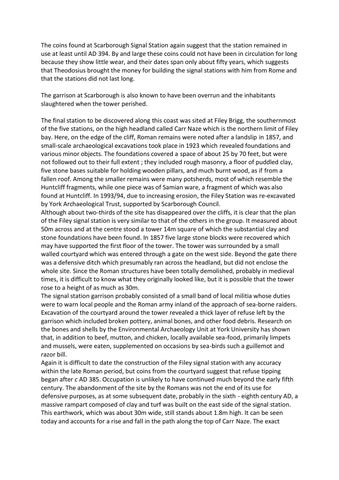The coins found at Scarborough Signal Station again suggest that the station remained in use at least until AD 394. By and large these coins could not have been in circulation for long because they show little wear, and their dates span only about fifty years, which suggests that Theodosius brought the money for building the signal stations with him from Rome and that the stations did not last long. The garrison at Scarborough is also known to have been overrun and the inhabitants slaughtered when the tower perished. The final station to be discovered along this coast was sited at Filey Brigg, the southernmost of the five stations, on the high headland called Carr Naze which is the northern limit of Filey bay. Here, on the edge of the cliff, Roman remains were noted after a landslip in 1857, and small-scale archaeological excavations took place in 1923 which revealed foundations and various minor objects. The foundations covered a space of about 25 by 70 feet, but were not followed out to their full extent ; they included rough masonry, a floor of puddled clay, five stone bases suitable for holding wooden pillars, and much burnt wood, as if from a fallen roof. Among the smaller remains were many potsherds, most of which resemble the Huntcliff fragments, while one piece was of Samian ware, a fragment of which was also found at Huntcliff. In 1993/94, due to increasing erosion, the Filey Station was re-excavated by York Archaeological Trust, supported by Scarborough Council. Although about two-thirds of the site has disappeared over the cliffs, it is clear that the plan of the Filey signal station is very similar to that of the others in the group. It measured about 50m across and at the centre stood a tower 14m square of which the substantial clay and stone foundations have been found. In 1857 five large stone blocks were recovered which may have supported the first floor of the tower. The tower was surrounded by a small walled courtyard which was entered through a gate on the west side. Beyond the gate there was a defensive ditch which presumably ran across the headland, but did not enclose the whole site. Since the Roman structures have been totally demolished, probably in medieval times, it is difficult to know what they originally looked like, but it is possible that the tower rose to a height of as much as 30m. The signal station garrison probably consisted of a small band of local militia whose duties were to warn local people and the Roman army inland of the approach of sea-borne raiders. Excavation of the courtyard around the tower revealed a thick layer of refuse left by the garrison which included broken pottery, animal bones, and other food debris. Research on the bones and shells by the Environmental Archaeology Unit at York University has shown that, in addition to beef, mutton, and chicken, locally available sea-food, primarily limpets and mussels, were eaten, supplemented on occasions by sea-birds such a guillemot and razor bill. Again it is difficult to date the construction of the Filey signal station with any accuracy within the late Roman period, but coins from the courtyard suggest that refuse tipping began after c AD 385. Occupation is unlikely to have continued much beyond the early fifth century. The abandonment of the site by the Romans was not the end of its use for defensive purposes, as at some subsequent date, probably in the sixth - eighth century AD, a massive rampart composed of clay and turf was built on the east side of the signal station. This earthwork, which was about 30m wide, still stands about 1.8m high. It can be seen today and accounts for a rise and fall in the path along the top of Carr Naze. The exact
Issuu converts static files into: digital portfolios, online yearbooks, online catalogs, digital photo albums and more. Sign up and create your flipbook.
